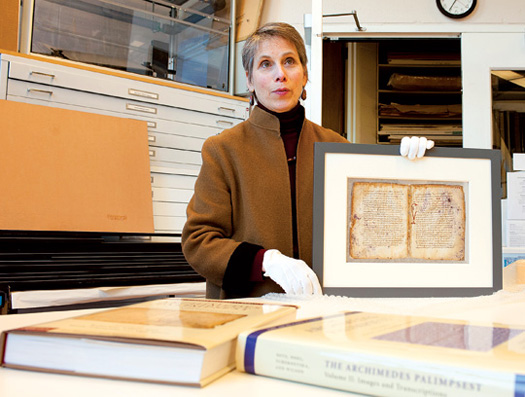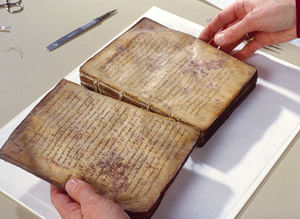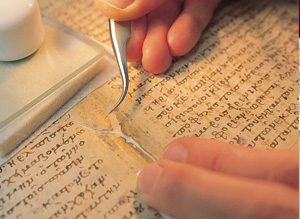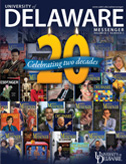
Paper trail
Conservator's painstaking detective work reveals ancient texts
ALUMNI | When Abigail Quandt, AS83M, first saw the ancient book whose fragile parchment pages contained some of Archimedes' most important mathematical thinking, she could be forgiven if her heart sank.
The priceless historical document was in dire condition. Over the centuries, its pages had been written on, erased and written over numerous times, portions of it overlaid with paint in an effort to pass it off as an illuminated prayer book. It had been badly damaged by water, attacked by mold, eaten away by bacteria and spotted with wax that had dripped from candles in medieval monasteries. Its leaves had been glued, taken apart and glued again—occasionally with pages out of order or even missing and with adhesive covering some of the original writing—before its 1998 sale to a private collector who brought it to the Walters Art Museum in Baltimore to repair and save.


Quandt, the museum's senior conservator of rare books and manuscripts and a graduate of the Winterthur/University of Delaware Program in Art Conservation, says she knew the project would be the most challenging of her career. But she also says she was hopeful about the eventual outcome.
"With such a complicated process, it's very important to be an optimist, to know that somehow, with the help of your colleagues, you'll figure out answers to the problems," Quandt says.
Still, she says, the conservation of the book turned out to be "like an archaeological dig," requiring the most painstaking efforts to uncover the layers of writing that had been placed on the parchment. It took four years of work just to take apart the folios of the book without causing any additional damage.
The manuscript is known as a palimpsest, a word derived from the Greek meaning "scraped again." By the time it arrived at the Walters, it was a Byzantine prayer book that had been completed in 1229. But scribes had copied the prayer book onto old parchment, an ancient form of recycling in which the original writing was scraped off so that the scarce material could be reused for a new manuscript. Most of the book was written on parchment that originally contained seven of Archimedes' treatises, copied by scribes in the 10th century.
"These were the oldest known treatises of Archimedes; since he lived in the third century B.C., it was a copy of a copy of a copy," Quandt says. "There are so few of these copies in existence because so few people understood his theories [which form the basis for such fields of mathematics as combinatorics and integral calculus]. There was tremendous excitement about this manuscript."
After separating the book into its folios, repair work began. Quandt and her team reinforced all the mold-damaged leafs, mended rips in the parchment, replaced fragments that had torn off, removed the drops of wax that had trapped dirt and dust over the years, located pieces of the book that were out of place and returned them to their original location and, eventually, stabilized each leaf on a special type of Japanese tissue paper and preserved each in a two-way glass frame, so that both front and back of the pages can be viewed on display.
"There's no doubt that this was the biggest and most challenging project I've ever worked on," Quandt says. "I'd specialized in manuscripts and in parchment preservation, but I'd never worked on a palimpsest before. In fact, not many people have; there are only about 1,000 palimpsests in collections around the world, and very few of those have been taken apart."
Still, she says, she solicited and received help from experts around the world, including those at Winterthur, at each step of the process. By 2006, technology had advanced to the point that a specialized kind of X-ray imaging could be used to scan through the paint on some pages of the palimpsest and pick up the iron in the underlying ink. Quandt made three visits to the Stanford Synchrotron Radiation lab, where the new technology using extremely bright X-rays was in use, and watched as the pages were successfully scanned.
"They did this as a kind of scientific experiment to see if it would work," she says. "There were people next to us in the lab who were scanning moon rocks. It was very cool."
Midway through the process, it was found that the original parchment had contained more than the seven treatises of Archimedes. Other texts had also been scraped and reused, including third-century commentaries on Aristotle and two speeches by the fourth-century orator Hyperides. Until then, scholars had assumed that Hyperides' works didn't survive the Middle Ages.
"It just blows your mind," Quandt says. "It's a voice from the past that doesn't survive anywhere else."
When the project was completed, the Walters exhibited the palimpsest early this year, along with detailed descriptions of the meticulous conservation process, before returning it to its owner.
"When we began this project, we knew it would take awhile, but we never imagined it would take 12 years," says Quandt, describing herself as both relieved and "wistful" at the completion of the work.
"It's been an amazing journey," she says. "I've learned so much from working on this palimpsest."
Article by Ann Manser, AS73





